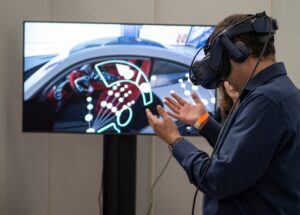Metaverse: Virtual-Reality and Augmented-Reality
Metaverse is the combination of both virtual reality and augmented reality. The internet’s progression set out in the 1970s and has undergone multitudinous changeovers to make an appearance in the new millennium. It was not feasible to prognosticate what the internet-dominant world would look like. The decades have already seen the enlargement of new devices and technologies. During the early stages of every new technology, there have been countless prospects for predictions. Likewise, there is a plethora of prognostications, yet many are excited about the new arrival.
Moreover, there has been a lack of knowledge. Here we see a glimpse of the upcoming technology. It is essential to keep track of the technology related to the Metaverse technology in preparation for learning.
“Virtual reality is not just technology, it’s an entirely new way of experiencing the world.”
Virtual reality(VR) is a technology that offers real experiences of various environments. VR entertains users by providing them with realistic sensations of light, sound, touch and sometimes even smell and taste. VR can be used for various purposes, such as gaming, education, training, tourism, therapy, and art. VR has the potential to create positive impacts on society by enhancing learning outcomes, improving mental health, and fostering creativity. David Em became the first artist to fabricate a traversable virtual environment in NASA’s jet propulsion Laboratory in which users could stroll around the streets. Subsequently, it gets developed by various individuals.
Virtual Reality primarily concerns VR headsets, Motion trackers, and Controllers that entertain users efficiently. It gives the satisfaction of being the one in the digital ecosystem. Furthermore, it dispenses images, sounds and other sensations that replicate a user’s physical existence in virtual surroundings. Virtual reality is utilized in a variety of fields, one of them is a simulator for driving, this creates the impression of actually driving on the road. Moreover, to create a realistic environment, it is requisite to precisely inscribe 3D data.
After virtual reality, there comes Augmented Reality(AR). Augmented reality is the bridge between the physical and the digital realm. The concept first occurred in Frank L Baum’s novel in which a set of electronic glass mapped data onto the people. Augmented reality brings the computer-generated environment to the real world. The prominent value of augmented reality is mixing the elements of the digital world into the person’s imagination through the integration of realistic sensations that are viewed as the natural parts of the environment.
Augmented reality involves certain components like display devices which could be smartphones, tablets or AR glasses, GPS, accelerometer, gyroscopes, and cameras to get the user’s position and orientation in the real world. User interface for users to engage with AR content such as touch, gestures and voice commands. One of the examples of Augmented reality is the game Pokemon Go. Tim Cook defined Augmented reality as follows,
“Augmented reality will change the way we see and interact with the world”
What is Metaverse?
The meaning metaverse can be defined as the assimilated virtual shared space, fabricated by the blending of virtually enriched physical reality, augmented reality (AR), and the Internet. It’s the network of continuous, real-time offered 3D worlds and simulations.
It’s an artificial universe where users communicate in real-time through avatars. It is currently in the process of enlargement and the developers are excited to create a virtual world, where people across the world would live, work, shop, learn, and interact with each other, all from the comfort of their physical world.
What makes Metaverse excited?
It is palpable that many tech giants have invested billions of dollars to bring Metaverse into reality. Metaverse is a digital ecosystem built on diverse classes of 3D technology, real-time collaboration of software and blockchain-based decentralisation finance tools. The Metaverse is a dynamic, open and interoperable space much like the internet but in 3D. Metaverse smudges the stripe amidst physical and digital worlds, presenting extensive opportunities for creativity, exploration, and connection.
It’s a distinct space where users can contour their own experiences, interact with others, and even monetize virtual assets. Moreover, the Metaverse is the replica of imagination. People can comprehend, experience and be one in the digital world. There are many potential uses for Metaverse like social interaction, entertainment and gaming, and virtual commerce in which users can buy, sell, and trade goods and services in the virtual marketplaces. Besides, it can be utilised in health care, art and creativity, exploration and adventure, but the latent applications of Metaverse are vast and continually augmenting as the technology progresses.
A Brief History of Metaverse:
The term Metaverse is coined by Neal Stephenson, author of “Snow Crash” a science fiction novel. In this, Metaverse is depicted as a virtual-reality-based successor to the Internet, where users connect in a digital environment through avatars. This gave the inspiration to lay the conceptual groundwork for Metaverse.
It all started in 1838 when scientist Charles Wheatstone pioneered the thought of “BinocularVision” where two images, one for each eye make a single 3D image. This notion laid the foundation for the rising technology like virtual reality. In the 1990s Sega unveiled the SEGA VR-1 motion simulator, subsequently, Palmer Luckey invented the Oculus Rift VR headset in 2010.
Facebook got an Oculus headset for $2 billion and made a deal to work together and develop more games. In 2016, Microsoft’s HoloLens gave the concept of mixed reality which helps to create a holographic image by putting them into the real world using Augmented Reality. In 2017, IKEA, a furniture company joined the Metaverse Mix and created an innovative application which permits users to select a piece of furniture and view it when it is placed inside the home or office.
Facebook changed its name to Meta in 2021 to emphasise and reshape the future of Metaverse, while it has also launched portable Virtual- Reality headsets.
Future of Metaverse:
Metaverse encompasses digitally augmented work areas which furnishes multiple privileges to both the organization and individuals. This optimizes communication, and interaction with the team for an extensive mixture of endeavours. Corporations are exerting to form a virtual environment that ameliorates the effective collaboration of the employees. In the gaming industry Metaverse plays a crucial role, the player will get the complete package of entertainment with enriched digital spaces.
The future of Metaverse relies on two factors: how well it can connect people efficiently and how to make things work. It will be distinguished by accelerated economic advancement, and innovations in hardware, software and connectivity. VR and AR will become more accessible and sophisticated. AI algorithms will power intelligent virtual environments, encouraging realistic simulations and personalized experiences. Furthermore, the proliferation of 5G will facilitate seamless connectivity consenting users to access the Metaverse anytime, anywhere.
What Might be the Cons of Metaverse?
Despite offering constructive consequences, it also holds potential adversities too. Spending too much time in digital worlds could lead to obsession. Besides, it may affect both physical and mental health. The immersive nature of Metaverse will make users vulnerable to identity theft, surveillance, and data breaches especially if privacy protections are not in place. Over-reliance on the digital world will alienate us from real-world relationships and exacerbate the feeling of loneliness and disconnection. In virtual environments, users can create personal versions of themselves or fabricated personas. Lack of authenticity may lead to trust issues and transparency.
The Metaverse raises complex ethical questions related to content moderation, censorship, and digital rights. Stabilizing Liberty of articulation with the necessity to watch over users from offensive content will be a challenge to platform manipulators. As the Metaverse starts, it leaves a carbon footprint, exacerbating climate change and environmental deterioration. Confronting the pitfalls will aid in elevating Metaverse as a more fortified place for all users without relinquishing privacy, security, or social cohesion.
“In the Metaverse, the only limit is your creativity, says Mark Zuckerberg.“The journey towards the Metaverse began with the Internet, which placed the core of interconnected digital spaces. Over time, enhancements in Virtual reality, Augmented reality, and Artificial intelligence pulled us closer to the experience of immersive and interlinked simulated zones. In Metaverse one can shift from one digital space to another without hindrance.
From online gaming platforms to virtual social spaces, the Metaverse is already manifesting in various forms, offering glimpses of its transformative potential. ”Technology makes what was once impossible possible” by Michael Gagliano. As we navigate towards the Metaverse era, it is crucial to address these issues thoughtfully, ensuring that the benefits of the interconnected virtual realm are accessible to all while protecting individual rights and fostering a thriving digital society.


























